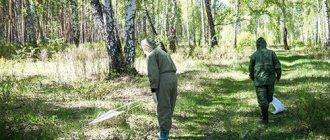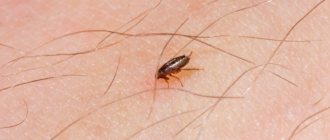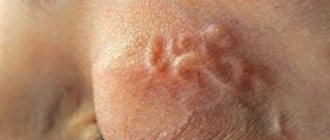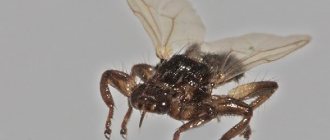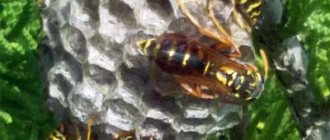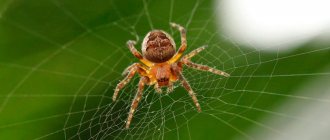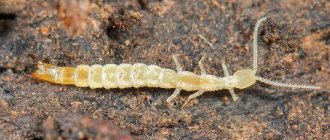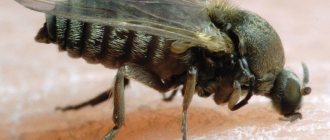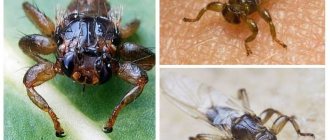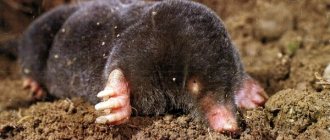Many cat owners do not realize that their pets, even in an exclusively home environment, can develop not only fleas, but also lice. Moreover, very often these insects coexist with each other in the animal’s fur, causing it many health problems. How do lice in cats differ from other parasites, how to treat them, and whether they can spread to people - the answers to these questions will be of interest to many pet owners.
Lice in a cat's fur
Lice in cats can appear at any time, even when the animal is completely domestic and does not leave the apartment. In cats and other pets, lice are called lice (lat. Felicola subrostratus) - parasites that feed on hair and the upper exfoliating layers of skin. They are not capable of biting through the epithelium and feeding on blood, as is the case with ordinary human lice.
As you can see in the photo of cat lice, they are much smaller in size compared to human lice, have a rounded body and a large triangular head, in front of which there is a recess for capturing the animal’s hair. Their jaws are quite strong and are designed to bite off pieces of skin, which causes severe itching in the animal. They cannot jump, they move very slowly, so if you look for them carefully, you can easily see them.
Lice on a cat
On a note!
Lice-eaters differ from ordinary fleas in color: lice have a light yellow tint, and jumping insects are brown or black.
How do animals become infected?
Such parasites cannot remain without a host for a long time, so infection is only possible through direct transmission from the host. At risk by default are dogs and cats that often walk outside. Animal grooming tools can be considered one of the sources of infection. If the groomer has previously had cats or dogs infected with lice, then your pet is most likely to develop lice.
Even with intensive damage to the animal in advanced cases, when anemia and aggravated dermatitis sets in, people are out of the risk zone. The reasons for lice in humans are completely different and you do not need to be afraid. It is better to promptly begin treatment for your pet.
Reproduction and nutrition of lice eaters
Cat lice spend almost their entire life living in the hairs of the fur and clinging to them close to the skin. While feeding, they crawl onto the body and chew off the epidermis piece by piece, then return back.
Eggs of lice eaters During the breeding season, females lay eggs, moving along the hair and gluing the larvae with the help of a special secretion, which is clearly visible in the photograph. Nits are covered with a mucous membrane, it quickly hardens, a young individual is formed inside it, which will come out in a few days. The size of the larvae is 1-2 mm.
Important!
One female is capable of laying 50-70 eggs in a short time; the larval development cycle is 25 days. Due to such a high reproduction rate, they can quickly turn the life of a pet into a real hell, causing exhaustion and dermatological diseases.
Symptoms of lice
The louse pierces the cow's skin, damaging the capillaries, and injects liquid into the wound opening, which interferes with the normal blood clotting process and contains toxic substances. Due to the constant crawling of lice over the body and massive damage to the skin, animals become aggressive and agitated or, conversely, lethargic. Against the background of severe itching, cattle eat poorly, lose weight, and the risk of other systemic diseases increases.
Lice on a cow look like wingless dark insects with a thick outer shell; upon careful examination of the hair, in its thickness you can see white eggs of parasites - nits. They are firmly attached to the fur, it is difficult to remove or shake off nits, they reach a diameter of 1 millimeter, and are often located on the head, around the neck and horns, and tail. The main symptoms of pediculosis in cattle:
- altered behavior - the cow is worried and may suddenly jump out of place when lying down;
- trembling throughout the body - the animal tries to get rid of the itching, constantly rubbing against walls, fences and other objects;
- loss of appetite and body weight;
- decrease in milk yield due to constant itching and stress of cows;
- the presence of numerous bites on the animal’s skin;
- the appearance of anemia in calves, a noticeable lag in physical development.
See also
Symptoms and diagnosis of rickets in calves, treatment and preventionRead
In the most affected areas of the animal's skin, areas of eczema and boils, nodules and hemorrhages appear. Prolonged scratching of itchy surfaces with various objects leads to the fact that the livestock develops cellular infiltration - the sweat and sebaceous glands cannot fully function, which affects the functioning of the entire body. The situation is aggravated by the fact that multiple pathogenic microorganisms penetrate into cracks and wounds on the animal’s skin.
Treatment methods
Treatment of lice in cats Severe health complications threaten street cats more, but it is quite easy to help pets.
Measures to combat cat lice are taken in the same way as methods for removing fleas from animals:
- The insecticide in the form of drops is applied to the cat’s withers and along the upper part of the spine, which will destroy fleas and lice parasitizing in the fur, and will also provide protection in the near future from attacks by blood-sucking insects. The most popular products: Bars, Bayer, Hartz, Frontline.
- Sprays and aerosols with the same names, which are used to treat the animal's fur for several days, are recommended to be used if the skin does not have severe scratches or wounds.
- The use of pet shampoos against fleas and lice will help cope with this problem if the cat is calm about the bathing process. This method must be used repeatedly, since the weak insecticide in the shampoo only affects adults, and nits in cats have a durable chitinous shell through which the poison does not penetrate. Therefore, when a new generation of parasites hatches from the eggs after 7-14 days, the treatment should be repeated 1-2 times.
- Using flea and lice collars will help prevent re-infestation, but some cats do not take kindly to them.
Treatment of cats and dogs
To treat animals affected by lice or lice-eaters, the same means are used as for prevention - shampoos, collars, sprays, emulsions, drops on the withers. Dog or cat collars, clothing, brushes, and bedding must be boiled or replaced. The cage, booth, floor and other equipment in contact with the animal are also subject to disinsection.
When treating your pet with sprays and other drugs, do not allow them to come into contact with the eyes, nose or respiratory tract. Improper use can lead to loss of coordination, nausea, and increased salivation. To safely treat lice on your cat or dog, strictly follow your veterinarian's recommendations.
Preventive measures
Many owners do not even know whether cats have lice, because often these insects die during timely preventive measures, which include regular treatment of the pet with insecticidal preparations against fleas. Such remedies also act on the lice-eaters that live in the cat’s fur. The effect of the drug lasts several weeks, during which all the parasites manage to die, and the young individuals hatched from the eggs face the same fate as soon as they begin to feed.
Treatment
Lice are easily killed by insecticides, so getting rid of them is usually not difficult. If the pet is kept in an apartment, it is washed with anti-parasitic shampoo (for example, Lugovoi), and after 3 days, a flea and tick drug in the form of drops is applied to the withers or an insectoacaricidal collar is put on. When washing, contact of foam with wool and skin should be 5-7 minutes.
For kennel dogs or aggressive cats, they are limited to applying spot-on preparations (“Bars”, “Bars Forte”) to the skin. This is enough to kill insects. You can use insectoacaricides in spray form.
Since the shell of eggs (nits) is very durable and not all insecticides penetrate through it, preference should be given to long-acting preparations.
Lice and lice more often affect young animals, and when choosing a drug, you need to take into account not only the body weight, but also the age of the animals. Bars Forte drops for puppies and kittens are approved for use from 10 weeks of age.
If small puppies or kittens, pregnant or malnourished animals are infected with lice, your veterinarian will recommend a special remedy. You need to get rid of parasites in any case, but it is important to avoid side effects from insectoacaricides.
If an outbreak of trichodectosis or siphunculatosis occurs in a nursery or shelter, it is rational to use a product that is suitable for treating not only the animals themselves, but also the premises - “Delcid”. It is an insectoacaricide from the pyrethroid group.
Before use, consult a veterinarian.
About the ways parasites spread
Parents must teach their children what to do in kindergarten. At school, on the playground you cannot take someone else’s hat or panama hat, ask them to wear an elastic band, and even more so, you should not comb your hair with someone else’s comb. It's better to look a little disheveled.
If a friend is infected with parasites, then they can crawl through his hair when you lean head to head, lie on the grass or sit in the sandbox nearby. In kindergartens, lice are transmitted through pillows. It’s good that lice don’t jump and don’t have wings. Otherwise, half the globe would regularly do prevention. The parasite lives outside the human body, without feeding on its blood, for only a day.
If a child lies on the pillow where a brother or sister or friend who was infected with pediculosis had previously been lying, then the lice remaining there will crawl onto the head. If friends come to your child’s house to play, after they leave you need to vacuum upholstered furniture, carpets, remove and wash pillowcases.
Treatment with folk remedies
Many livestock farmers are wary of using chemicals and prefer folk remedies. How to remove lice from a goat using the experience of our ancestors? Most often used:
- Regular vegetable oil, which is rubbed into the animal's fur. It creates a film that does not allow air to pass through. Lice are uncomfortable in such conditions, so they leave their prey.
- Ash or tar. This is one of the safest methods of treating lice, which is used even for small kids. The ash is rubbed into the skin and left for a week, then the procedure is repeated. Apply the tar for a day, then wash it off and repeat the treatment twice, with an interval of 7 days.
- Sagebrush. A decoction should be prepared from the medicinal plant and the affected areas should be treated. You can also feed grass
- Garlic infusion. To prepare the medicine, you need to chop 5-7 cloves of garlic, pour 100 ml of boiling water and leave for 12 hours to infuse. The resulting product is used to treat lice-affected areas.
Important! When using either method, remember that many substances can further irritate the skin.
Types of lice in humans
The following types of human ectoparasites can parasitize humans:
- head;
- wardrobe,
- pubic.
The head louse is the most common species and can only feed on human blood. The habitat is the scalp of a person. In relatively rare cases, you can find head lice parasitizing on a man's beard or sideburns.
Externally, it is a grayish-brown insect. The adult size reaches 4 mm. Nits are tightly attached to the hair and look like small, light-colored eggs. The reproduction activity of this species of ectoparasites does not depend on the time of year.
Various special shampoos and sprays are used to combat head lice. Alternatively, you can shave your head bald.
Linen (another name for clothes) ectoparasites are similar in size to head ectoparasites, but their body color is white or light grayish. This type of bloodsucker has adapted to living on the surface of clothing, which either constantly or very often comes into contact with human skin. The parasitism of linen ectoparasites on hair is completely excluded.
Most often, people without a fixed place of residence suffer from linen lice, who, due to circumstances, cannot maintain personal hygiene and regularly change clothes.
In this case, linen nits are deposited directly on the fabric. They can most often be found in the folds of seams, so the fight against them comes down to careful processing of clothing - here the method of boiling or hot steam is used.
Among all the varieties of human lice, pubic lice have the smallest body. The size of an adult does not exceed 2 mm, the nits are very small. They live exclusively on pubic hair. In rare cases, they can parasitize in the armpit and only as an exception live on the eyebrows and eyelashes.
Infection occurs in most cases through sexual contact. But there are cases where people become infected with lice pubis while swimming or wearing only underwear. Treatment: shaving the groin.
A sign of the presence of lice is constant itching of the scalp or groin caused by a bite. Infection with any type of lice occurs during contact between a sick person and a healthy person. For example, children can get the disease in kindergarten while playing together with an infected child.
How to clean your house to get rid of lice?
Thoroughly vacuum floors, carpets, and upholstered furniture. Change the bed linen. Wash it in hot water. When dry, iron everything with a hot iron. It doesn't hurt to wash all the soft toys. There is no point in simply sealing them in bags. The main thing is that you must understand if your child brought home lice, he became infected from a friend or in some public place, but not from a pet. The latter will not need to be taken to the veterinarian or treated with anti-flea drugs.
- Pets
- children
- lice
March 12, 2018| 19:01
Prevention measures
The best way to treat pediculosis and the subsequent addition of concomitant skin diseases to it is timely prevention, which includes:
- control of the quality of livestock nutrition - it is important to balance the diet, include vitamin supplements to strengthen the immune system;
- compliance with sanitary requirements in stalls - regular disposal of manure, replacement of bedding, protection of animals from drafts and dampness;
- periodic treatment with repellents of the favorite habitats of lice - the spine, tail, neck and head of the cow;
- regular treatment of the stall with antiseptic agents;
- routine examinations by a veterinarian, vaccination;
- monitoring the condition of the animal’s skin and coat, behavior, appetite, weight gain and physical development of calves.
The listed measures are not troublesome or expensive, but will allow you to prevent and timely detect pediculosis in cattle and select therapeutic methods in a timely manner.
To avoid infestation of cattle with lice, it is recommended to take preventive measures and treat the barn with antiseptic solutions before the stall period or in the summer. It is important to diagnose and begin to treat head lice in a timely manner, since massive lesions on the skin of young calves can lead to the death of livestock.
Diagnosis, how and by whom it is made
Small cattle are most often parasitized by lice and lice. The former have a piercing-sucking type of mouthparts, while the latter have a chewing type. Lice feed on the blood and lymph of animals, lice eaters feed on skin particles, and their jaws injure the skin more severely.
Lice cause a disease called siphunculatosis. Symptoms of infection:
- Constant severe itching. The animal constantly tries to scratch itself on some object.
- Anxiety, sometimes aggression.
- Scratching and dermatitis appear on the body.
- Hair loss in some places.
- With severe infection, anemia develops.
- The skin loses elasticity, flakes, and becomes rough.
- The animal's appetite worsens and weight loss is noted. In advanced cases, death is possible.
To diagnose head lice, you can contact your veterinarian. But with a thorough examination of the animal, any livestock breeder can determine the presence of parasites himself. Lice are spreaders of other diseases - bacterial, viral, helminthic, protozoal. Ticks, flies, midges, mosquitoes are companions of lice. They quickly attack damaged areas of the skin. This interaction causes the greatest harm to the animal.
In areas affected by lice, scratches appear, where pathogenic agents penetrate, therefore, eczema, furunculosis or pyoderma are observed in infected animals. The immune system degrades, so pulmonary and intestinal worms, Eimeria, and piroplasma are attached.
Important! Lice in kids are transmitted to humans; they do not settle on the body, but are capable of transmitting contagium.
